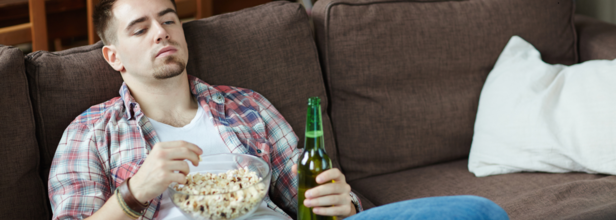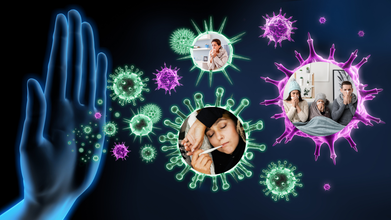- Health Conditions A-Z
- Health & Wellness
- Nutrition
- Fitness
- Health News
- Ayurveda
- Videos
- Medicine A-Z
- Parenting
Are You A Couch Potato? You May Be Prone To These 19 Diseases

Credits: Canva
The winter season compels us to sit at one place, under the blanket, at the ease of warmth. But aren't we all aware of the dangers of a sedentary lifestyle? And when it is winter, it makes it more so stagnant. Not just that, but now a new study from the University of Iowa says that being a couch potato could lead to 19 chronic conditions. Among the 19 chronic conditions, obesity, diabetes, depression and heart diseases also made it to the list.
Research shows that among many diseases, increased blood pressure, high blood sugar, excess body fat around the waist, unhealthy cholesterol levels that leads to metabolic syndrome, cardiovascular disease and cancer are also there. This is why any extended sitting whether at desk, behind the wheel or the screen can be harmful.
How was the study conducted?
The team of researchers from various departments at the University of Iowa conducted a detailed study where they analyzed records from over 40,000 patients at a major Midwestern hospital system. In the records, they looked at the extensive physical inactivity of these patients and how it impacted their overall health.
The study and the detailed analysis is published in the journal Preventing Chronic Disease and studies.
As part of conducting the study, a 30-second exercise survey was conducted. Then, patients were also asked two questions: how many days per week they engaged in moderate to vigorous exercise and for how many minutes per session? On the basis of response, the patients were categorized into three groups:
- Inactive - 0 minutes per week
- Insufficiently active - 1-149 minutes per week
- Active - 150 minutes per week
As per Lucas Carr, associate professor in the Department of Health and Human Physiology and study's corresponding author, "This two-question survey typically takes fewer than 30 seconds for a patient to complete so it does not interfere with their visit. But it can tell us a whole lot about that patient's overall health."
What did the study find?
The study got 7,261 responses, and it found that around 60% of them met the recommended guidelines for exercising. These people met the 150 minutes or more minutes of moderate exercise per week. However, almost 36% exercised less than 150 minutes per week and 4% reported no physical activity.
The study also found that people experienced lower rates of depression. 15% of people who exercise for 150 minutes or more, or at least for some amount of time could experience depression, as compared to 26% of those who are inactive. Similarly, for obesity, the numbers are 12% versus 21% for obesity, 20% versus 35% for hypertension and the similar trend was seen in other diseases, and markers of good health, including lower resting pulse rates, and cholesterol profiles.
Patients with no physical activity carried a median of 2.16 chronic conditions, this number was 1.49 conditions in insufficiently active patients and dropped to 1.17 in active patients.
The 19 chronic conditions are:
- Obesity
- Live disease
- Psychoses
- Chronic Lung disease
- Neurological seizures
- Coagulopathy (blood clotting disorder)
- Depression
- Weight loss issues
- Uncontrolled hypertension (high blood pressure)
- Controlled hypertension
- Uncontrolled diabetes
- Anemia deficiency
- Neurological disorder affecting movement
- Peripheral vascular disease
- Auto Immune Disease
- Drug Abuse
- Hypothyroidism
- Congestive heart failure
- Vulvar disease (heart valve problem)
Is It Safe To Drink Alcohol On Ozempic? Doctors Say The Effects Can Be Stronger

Credits: Canva
Ozempic (semaglutide) has quickly become a widely used drug for managing type 2 diabetes and supporting weight loss. With its growing use, many people are wondering whether it has any interaction with alcohol. There have also been reports suggesting that Ozempic may reduce alcohol cravings in some users.
While it is not always necessary to completely avoid alcohol while taking Ozempic, doctors say there are certain side effects and risks that should not be ignored. To understand this better, we spoke with Dr Monika Sharma, Senior Consultant in Endocrinology at Aakash Healthcare.
Can Ozempic Make Alcohol Hit Twice as Hard?
Yes, alcohol can feel noticeably stronger when taken alongside medications like Ozempic, and this has a lot to do with how the drug alters digestion, metabolism, and brain signalling. Ozempic belongs to a class of medicines called GLP-1 receptor agonists. It is primarily prescribed for type 2 diabetes and is increasingly used for weight management. One of its key actions is slowing down stomach emptying, meaning that both food and liquids stay in the stomach longer before moving into the intestines.
Dr Sharma explains, “When alcohol is consumed, delayed gastric emptying can lead to uneven absorption. In some people, alcohol enters the bloodstream later but more rapidly once absorption begins, which can raise blood alcohol levels faster and intensify intoxication even with smaller amounts.”
Ozempic and Alcohol: Reduced Appetite and Drinking On An Empty Stomach
Another major factor is appetite suppression. Many people on Ozempic eat significantly less or skip meals altogether, either intentionally or due to reduced hunger. Drinking alcohol on an empty or nearly empty stomach allows it to be absorbed more quickly, as there is little food to slow the process. As a result, an amount of alcohol that once felt manageable may suddenly cause dizziness, flushing, nausea, or loss of coordination much sooner than expected.
Ozempic and Alcohol: Brain Effects and Alcohol Sensitivity
Ozempic also affects areas of the brain linked to reward, fullness, and impulse control. Emerging research suggests that GLP-1 receptor agonists may lower cravings for substances like alcohol, while at the same time increasing sensitivity to its effects. This means that even if the desire to drink decreases, the body’s reaction to alcohol may feel stronger or more unpleasant. Many users report unusual tiredness, light headedness, or nausea after just one drink, often describing it as alcohol “hitting twice as hard.”
Ozempic and Alcohol: Blood Sugar Changes and Hypoglycemia Risk
Blood sugar regulation is another concern. Alcohol can cause fluctuations in glucose levels, and when combined with a medication that tightly controls insulin release and glucose use, the risk of low blood sugar increases, particularly for people with diabetes. Symptoms of hypoglycemia include sweating, shaking, confusion, and palpitations. These signs can resemble alcohol intoxication or worsen its effects, making the experience more intense and potentially dangerous.
Ozempic and Alcohol: Dehydration and Slower Recovery
Dehydration also plays a role. Ozempic can cause side effects such as nausea, vomiting, and reduced fluid intake, all of which increase the risk of dehydration. Alcohol further depletes fluids, and when the body is already low on hydration, alcohol’s impact on the brain and heart becomes stronger. This can lead to faster intoxication, headaches, and a longer recovery time after drinking.
Ozempic and Alcohol: Gut Sensitivity and Worsening Side Effects
Gastrointestinal sensitivity should also be considered. Ozempic commonly causes nausea, bloating, acid reflux, and stomach discomfort, especially in the early months of treatment. Alcohol irritates the stomach lining and relaxes the lower oesophageal sphincter, which can worsen these symptoms. Together, even small amounts of alcohol can trigger stronger negative reactions, reinforcing the feeling that tolerance has suddenly dropped.
Why Alcohol Feels Stronger On Ozempic
While Ozempic does not directly interact with alcohol the way some medications do, its indirect effects on digestion, hydration, metabolism, and the nervous system can make alcohol feel more potent. This is why moderation is strongly advised. People taking Ozempic should limit alcohol intake, avoid drinking on an empty stomach, stay well hydrated, and pay close attention to how their body responds.
In short, Ozempic can make alcohol feel stronger not because it increases alcohol levels directly, but because it changes how the body processes and reacts to alcohol. Being aware of this interaction can help people make safer, more informed choices while using this medication.
Indoor Air In Delhi Is More Toxic Than Outdoor Smog, Pulmonologist Warns

Credits: Canva
Dense, toxic smog covered India’s capital on Monday, driving air pollution to its highest levels in weeks, disrupting travel, and prompting authorities to enforce the strictest containment measures. More than 40 flights were cancelled, with several dozen more delayed. Over 50 trains arriving and departing from New Delhi faced delays of several hours, officials reported. Healthcare experts urged residents to stay indoors as hospitals recorded a surge in patients with breathing problems and irritated eyes. Now, a pulmonologist is warning that indoor air in Delhi might actually be more hazardous than the smog outdoors.
Delhi Pollution: Indoor Air More Toxic Than Outdoor Smog
Indoor air quality in Delhi is reportedly worse than the air outside, according to a lung specialist. Dr. Vivek Nangia, head of pulmonology at Max Healthcare, said indoor spaces can have particulate matter, or PM2.5 levels, nearly two-and-a-half times higher than outdoor readings, even when there are no direct pollution sources indoors.
“Indoor air can be 20 to 30 times more polluted than outdoor air, so it’s important to monitor and improve it,” he explained. Studies have shown that lung-damaging tiny particles inside homes are “substantially higher” than what nearby government monitors report outdoors. This was also confirmed by a study conducted by the Energy Policy Institute at the University of Chicago (EPIC) between 2018 and 2020, which surveyed thousands of Delhi households across different income levels, finding that both rich and poor families are affected equally.
Researchers noted that wealthier households were 13 times more likely to own air purifiers than low-income ones, yet indoor pollution in those homes was only about 10% lower than in disadvantaged settings.
“In Delhi, the bottom line is—whether someone is rich or poor, nobody gets to breathe clean air,” said Dr. Kenneth Lee, the study’s lead author. “It’s a complex, vicious cycle.”
How Does Indoor Air Quality Affect Your Lungs?
Poor indoor air quality (IAQ) can harm the lungs by causing inflammation, weakening the body’s defenses, and triggering or worsening conditions such as asthma and COPD. Pollutants like dust, mold, VOCs, and smoke can lead to coughing, wheezing, infections, and long-term lung damage, even raising the risk of lung cancer over time. Because the lungs are constantly exposed to air, they are extremely sensitive to irritants, which can reduce lung function and capacity—particularly in children, older adults, and those with pre-existing conditions, according to the American Lung Association.
Dr. Nangia noted that patients are now showing a different kind of chest congestion. “These days we’re seeing two kinds of patients—those who never had lung issues before but are now coming in, saying their coughs, sneezing, and chest congestion started once air quality worsened, and those with existing lung problems who are experiencing much worse symptoms,” he said.
How To Protect Yourself From Indoor Toxic Air?
According to the American Lung Association, protecting yourself from indoor air pollution involves controlling sources of pollutants (no smoking, using low-VOC products), improving ventilation (opening windows, using exhaust fans), using HEPA air purifiers, cleaning regularly (dusting and vacuuming), managing humidity to prevent mold, and wearing N95 masks on days with high outdoor pollution to reduce indoor air infiltration.
Is 2025 The Year Of Flu?

Credits: iStock and Canva
Influenza and other respiratory viruses are surging, note the United Nations. In fact Dr Wenqing Zhang, Unit Head for Global Respiratory Threats at the Department of Epidemic and Pandemic Threats Management of the World Health Organization said that this year is marked by "the emergence and rapid expansion of a new AH3N2 virus subclade". This new variant is called J.2.4.1 or subclade K. This was first reported in August in Australia and New Zealand and has since been detected in over 30 countries.
2025 - A Year Of Flu
Earlier in November, the Public Health Ontario's (PHO) data revealed that Ontario and Canada as a whole could be in a "very tough" flu season this year, thanks to the Influenza A or the flu A. The PHO data revealed a 1.8% rise in influenza cases in the last week of October. Now, amid the influenza A outbreak, 3 children have died from the same in Ottawa and Eastern Ontario region.
US is also facing a flu outbreak and as per the Centers for Disease Control and Prevention (CDC) data, an estimated 2.9 million people have gotten sick so far this season. Among them, 1,200 have also died. This is the 'worst' flu season, point out many experts. For US, the country is seeing a post-Thanksgiving spike in influenza, and saw an 8% increase in people testing positive for the flu.
Super flu or the mutated variant of flu, clade K, has swept the world and caused an early spike in cases worldwide. In Australia, it has caused an early summer spike, while in the UK, it has caused a surge in hospitalization. As per the National Health Service (NHS) England, the number of cases of K flu has been increasing since December 7 and December 11. Hospitalization is up 55% in a week, noted NHS.
Is Flu Shot Effective?
The strain driving the current spike has picked up the nickname “super flu” because it is believed to be a mutated form of influenza A (H3N2), known as “subclade K.”
Influenza H3N2 does not circulate as often as some other flu strains. Dr Simon Clarke, associate professor of cellular microbiology at the University of Reading, explains that the letters “H” and “N” refer to two proteins found on the virus surface, haemagglutinin and neuraminidase. “The numbers simply tell us which versions of those proteins are present,” says Dr Clarke. “It’s a way of grouping strains. This year, H3N2 happens to be the one in the lead.”
“H3 subtypes are relatively uncommon,” he adds. “That means fewer people have built up immunity. There is also evidence they spread more easily and mutate faster, which makes them harder for vaccines to keep up with.
“What we are seeing now is the outcome of that: cases rising sharply earlier than usual, with numbers likely to climb further as winter goes on.”
Recent figures suggest the flu vaccine cuts the risk of hospital admission by roughly 30 to 40 per cent in older adults. That protection rate is lower than for some other vaccines, but it is in line with flu vaccine performance in past years. For that reason, advice has not changed. Vaccination remains the single most effective step people can take to protect themselves and to ease pressure on the NHS.
Super Flu or The K Strain
Known as the superfly, this is H3N2 'subclade K'. It is a type of seasonal influenza A virus and people have not encountered much of it in the recent years. This is why there is less immunity against it. However, the National Health Service (NHS), UK, has already sent out a 'flu jab SOS' to vulnerable people.
NHS has confirmed that the super flu is circulating in England this year, and due to less immunity, it is making it easier to spread across people. The UK Health Security Agency (UKHSA) has urged people to get a flu jab. As per the early data, this year's vaccine has offered good protection despite the new strain.
Daniel Elkeles, chief executive of NHS Providers, said that the major concern is that H3N2 is associated with a more severe illness and superflu could be "a very nasty strain of flu". He said that UK could be experiencing a "tidal wave" of illness.
What Is Influenza A?
As per the National Institutes of Health, US, influenza viruses that contains single-stranded RNA that are classified into three types: A, B, and C. Type A and B cause annual epidemics and even pandemics, while type C is a less common disease.
As per the Centers for Disease Control and Prevention (CDC), Influenza A viruses are descendants of the 2009 H1N1 pandemic virus that emerged in the spring of 2009 and caused a flu pandemic. These viruses, scientifically called the "A(H1N1)pdm09 virus," and more generally called "2009 H1N1," have continued to circulate seasonally since 2009 and have undergone genetic and antigenic changes.
Influenza A(H3N2) viruses also change genetically and antigenically. Influenza A(H3N2) viruses have formed many separate, genetically different clades in recent years that continue to co-circulate.
© 2024 Bennett, Coleman & Company Limited

